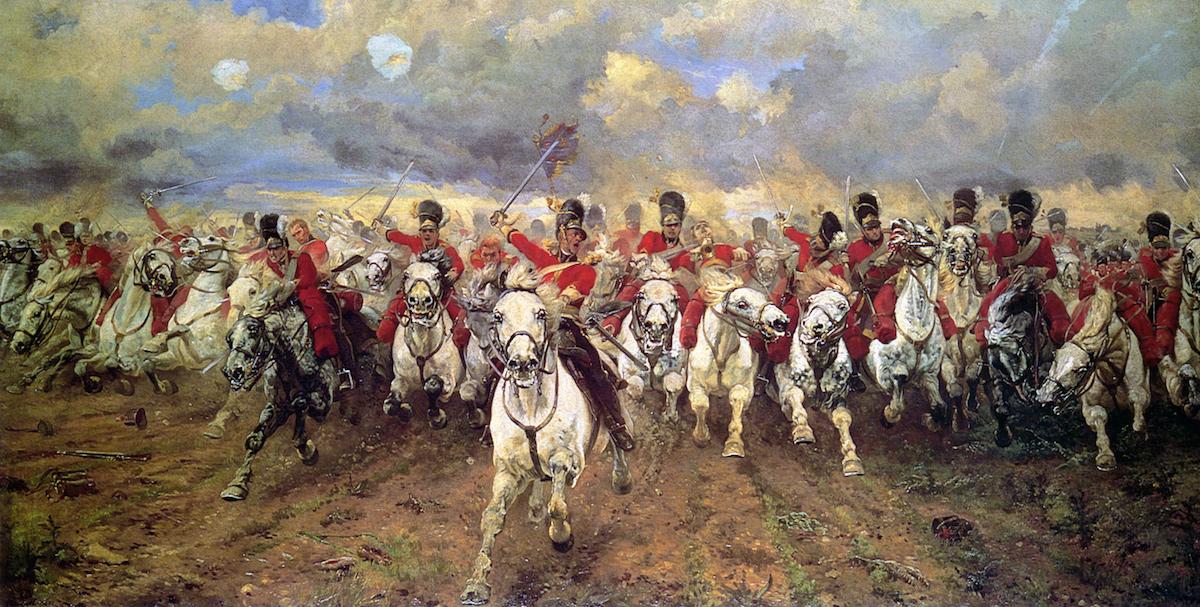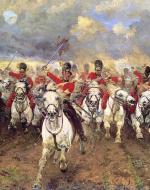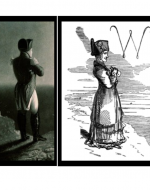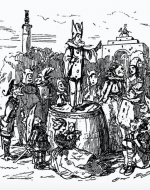Created by Emilka Jansen on Tue, 11/02/2021 - 09:31
Description:
The Battle of Waterloo was a major historical event that took place on June 18, 1815 in Waterloo, Belgium. Fought between Napoleon Bonaparte’s French army and a coalition led in joint efforts by the Duke of Wellington and Prussian Field Marshal Gebhard Leberecht von Blücher, the bloody battle was the culminating conflict of the Napoleonic Wars (1803-1815), which saw millions of casualties among both soldiers and civilians. The death count was staggering, but today’s society has reduced the sheer impact of the battle to numbers and song lyrics; a once never-forgotten battle has faded from collective memory but endures in the pages of William Makepeace Thackeray’s canonical Vanity Fair.
Elizabeth Butler, “Scotland Forever,” 1881, World History Commons.
Lady Butler, née Elizabeth Sutherden Thompson, was a prominent female artist who painted battle and military scenes—a subject that nineteenth-century society considered too violent and bloody for women. Her oil painting Scotland Forever depicts a British cavalry regiment known as the Royal Scots Greys; they charged alongside other soldiers at the Battle of Waterloo, calling “Now, my boys, Scotland forever!” (Leeds Art Gallery). This rallying cry became the title of the painting. Considered “one of the most popular and talked-about artists in Britain” during her prime years in the 1870s (Chilvers 369-370), Butler challenged the gender norms of her time, forcing John Ruskin to retract his sexist statement that “no woman could paint” (The Victorian Web). He would go on to admit that her art was “'profoundly interesting; and showing all manner of illustrative and realistic faculty’” (ibid). Indeed, Butler’s painting reveals her tremendous artistic abilities: she depicts both the men and horses realistically, drawing attention to how the individual makes up a part of the collective whole. Telling of her motives, Butler wrote in her autobiography that she “‘never painted for the glory of war, but to portray its pathos and heroism’” (qtd. in Chilvers 370). The soldiers who fought in the Battle of Waterloo certainly displayed heroic qualities, yet Thackeray's Geroge Osborne dies dishonorably face first in mud.
Top: William Makepeace Thackeray, “Sentimental and Otherwise,” in his Vanity Fair, 1848. Bottom: William Makepeace Thackeray, “The Girl I Left Behind Me,” in his Vanity Fair, 1848.
Thackeray uses the Battle of Waterloo to anchor his novel in a past historical moment, but he doesn’t join the combatants; instead, he stays behind with the female protagonists who await the return of their respective husbands. In doing so, Thackeray demonstrates the profound effect that war had on families, especially women. The top plate depicts a pensive Amelia in a scene that foreshadows how she will who anxiously await the return of George Osborne; she stares far past the edge of the frame, waiting for George to visit her, much as she will wait anxiously when George goes to battle, and Thackeray stays with the noncombatants. Conversely, Becky appears unfazed that her husband, Rawdon Crawley, is in the battle; she lies asleep, allowing her mind to be at rest. A faint smile assumes her countenance and is telling of her tranquil state, especially when compared to distraught Amelia. The characters' contrasting ways of coping reveal just how different Becky and Amelia are from each other. Through these illustrations, Thackeray not only distances the women from their respective husbands but also from each other.
Left: Benjamin Robert Hayden, "Napoleon Musing at St. Helena," 1830. Right: William Makepeace Thackeray, “Becky as the Little Corporal in Petticoats,” in his Vanity Fair, 1848.
A central plot device that advances Becky’s and Amelia’s narratives, the Battle of Waterloo also reveals all-important relics of the past that live on through Thackeray’s display of Victorian material culture. The following plate reveals several important objects: the bicorne, petticoat, and spyglass. Dressed from head to toe as the French conqueror, Becky emerges as a Napoleonic figure who is powerful, headstrong, and calculating, like Napoleon himself. In addition to her similarly tilted bicorne (two-cornered) hat, she wears a uniform over her petticoats, calling attention to the opening of Chapter XVIII: “Our surprised story now finds itself for a moment among very famous events and personages, and hanging on to the skirts of history” (211; emphasis added). The use of “skirts” here not only parallels “petticoats” to suggest similarities between the two figures but also reveals that Thackeray is skirting, or sidestepping, the present moment by jumping into the past. He does so to absolve himself of all responsibility and blame that may come with offending readers of his time. The resemblance in dress and posture between Hayden's Napoleon and Thackeray's Becky as Napoleon creates a striking mirror image where Napoleon and Becky are, respectively, gazing into the vast distance; Becky shares Napoleon's brute strength, determination, and French heritage.
William Makepeace Thackeray, titlepage of first edition, his Vanity Fair, 1848.
By retreating into the past, Thackeray turns history on its head. The following plate moves the viewer away from the foreground and into the background, revealing an upside-down jester mounted atop a barrel. An echo of the pictorial capital to Chapter XVIII, the jester here allows Thackeray to manipulate the strings of history as he reigns control of time and his characters. The presence of the jovial jester also imbues the scene with humor, guiding the viewer to the corner of the frame, where Becky holds Thackeray as a puppet. His scaled-down appearance alludes to the illustration at the end of Chapter IX, where he appears as a miniature cross-legged jester (104). Thackeray not only “‘enter[s] the story in his own voice’ as ‘there is nothing to keep him from talking’” (Van Ghent 114), but he also manifests in the illustrations as an extension of himself. Ultimately, he self-reflexively inserts himself, allowing history to determine the course of his own story.
ABBA at the 1974 Eurovision Song Contest in Brighton, England, published in The New York Times, 2020.
Moving away from the pages of Thackeray’s novel, pop songs such as ABBA’s “Waterloo” trivialize the importance of the battle and the impact it had on thousands of people. Written in 1974, the song by this Swedish pop group uses the Battle of Waterloo as a metaphor for a woman giving into her love for a man—he becomes her personal Waterloo, the place where Napoleon meets his defeat in 1815. ABBA uses the major battle that determines Amelia's and Becky’s destiny in Vanity Fair to parallel Napoleon’s fate with this woman’s surrender. The woman in ABBA's song falls completely for a man, promising to love him forever. The songwriters make this message clear in their lyrics: “My, my / At Waterloo, Napoleon did surrender / Oh, yeah / And I have met my destiny in quite a similar way” (ABBA). Although the song has many memorable lines, ABBA ultimately reduces the battle’s importance by turning it into a catchy, whimsical tune that has found its home in today’s popular culture.






